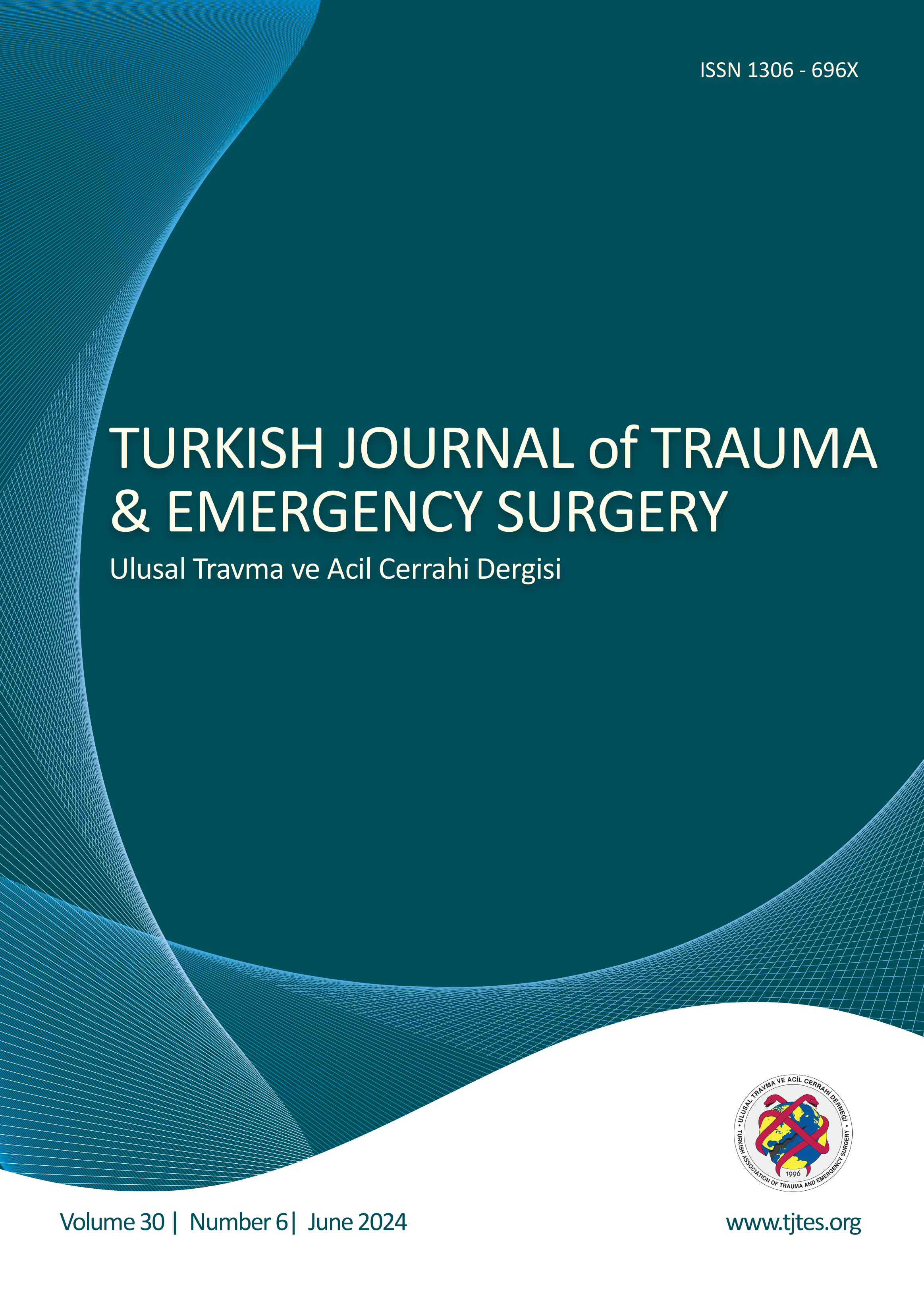Hızlı Arama
Künt çoklu travma hastalarında kan transfüzyonunu ihtiyacını tahmin etmek için laktat ve baz defisiti kombinasyon skoru
Engin Özakın1, Nazlı Özcan Yazlamaz1, Filiz Baloğlu Kaya1, Mustafa Emin Çanakçı1, Muzaffer Bilgin21Eskişehir Osmangazi Üniversitesi Tıp Fakültesi, Acil Tıp Anabilim Dalı, Eskişehir2Eskişehir Osmangazi Üniversitesi Tıp Fakültesi, Biyoistatistik Anabilim Dalı, Eskişehir
AMAÇ: Laktat ve baz defisiti (BD) değerleri, doku perfüzyonunun göstergeleri olarak değerlendirilen parametrelerdir ve yaralanma ve ölüm şidde-tinin belirteçleri olarak kullanılmıştır. Çalışmanın amacı kombine edilmiş skor ile kan transfüzyonu ihtiyacı arasındaki ilişkiyi 24 saat içinde belirlemek ve transfüzyon ile transfüzyon yapılamayan grup arasındaki değişkenlerin karşılaştırılması, laktatın, BD, fizyolojik ve laboratuvar parametreleri ile korelasyonu ve kan transfüzyonu ihtiyacı için başlıca risk faktörlerinin belirlenmesidir.
GEREÇ VE YÖNTEM: Çalışmaya künt çoklu travmalı toplam 359 hasta (245 erkek, medyan yaş: 40, min-maks: 1895) dahil edildi. Demografik veriler, laboratuvar parametreleri (hemoglobin, hematokrit, laktat, BD, pH), fizyolojik parametreler (sistolik kan basıncı: SBP; Diyastolik kan basıncı: DBP; kalp hızı: HR; solunum hızı: RR), Glascow Koma Ölçeği (GCS), şok indeksi (SI) ve Revize travma skoru (RTS) kaydedildi. Laktat ve BD de-ğerleri kullanarak elde edilen kombine skoru (CS) formülü oluşturmak için logistik regresyon yöntemi kullanıldı. Bu formüle göre 24 saat içinde kan transfüzyon ihtiyacı için olasılık değeri 0.092447509 hesaplandı. Elde edilen CS, olasılık değerinden daha yüksek ise, 24 saat içinde kan transfüzyonu ihtiyacı olacağı düşünüldü. Ayrıca, 24 saat içinde kan transfüzyonu gereksinimi için majör riskleri belirlemede tek değişkenli analiz kullanıldı ve kom-bine edilmiş skor, laktat, BD, SI ve RTSyi kendi aralarında karşılaştırmak için alıcı ROC analizi yapıldı.
BULGULAR: Transfüzyon ve transfüzyon yapılmayan gruplar arasındaki karşılaştırmasında SBP, DBP, HR, RR, SpO2, GCS, hemoglobin, hematokrit, laktat, BD, pH, SI ve RTS arasında farklılık anlamlı idi (her biri için p<0.05). Laktat değeri, SI, HR ile pozitif, BD, RTS, SBP, DBP ile negatif korelasyon gösterdiği tespit edildi. BD değeri, RTS, SBP, DBP, Hb ve Htc ile pozitif korelasyona, SI, HR ve RR ile negatif korelasyon tespit edildi. Kan transfüzyon ihtiyacı için major riskler SI, laktat, BD, SBP ve SpO2 idi. CS, 100 hastada (%27.85) 0.092447509 değerinden yüksek idi ve yüksek CSli 41 hastada 24 saat içinde kan transfüzyonu gerçekleştirildiği tespit edildi (p<0.001; OR: 21.803, duyarlılık %83.7, özgüllük %81, pozitif prediktif değer %41, negatif prediktif değer %96.9). ROC eğrisi, kan transfüzyonu ihtiyacı için CSnin (AUC: 86). SI ve RTSden daha anlamlı olduğunu gösterdi.
TARTIŞMA: CS, künt çoklu travmalı hastalar için 24 saat içinde kan ihtiyacının öngörülmesinde etkilidir.
Anahtar Kelimeler: Baz defisiti, formül; kan transfüzyon ihtiyacı; kombine; laktat; travma.
Lactate and base deficit combination score for predicting blood transfusion need in blunt multi-trauma patients
Engin Özakın1, Nazlı Özcan Yazlamaz1, Filiz Baloğlu Kaya1, Mustafa Emin Çanakçı1, Muzaffer Bilgin21Department of Emergency Medicine, Eskişehir Osmangazi University Faculty of Medicine, Eskişehir-Turkey2Department of Biostatistics, Eskişehir Osmangazi University Faculty of Medicine, Eskişehir-Turkey
BACKGROUND: Lactate and base deficit (BD) values are parameters evaluated as indicators of tissue perfusion and have been used as markers of severity of injury and mortality. Objectives: The aim of the study was to determine the relationship between combined score (CS) and blood transfusion need within 24 h and comparison of the variables between transfusion and non-transfusion group, correlation lactate with BD and with physiological, laboratory parameters, and determining the major risk factors of patients for the need for blood transfusion.
METHODS: The study included a total of 359 patients (245 males, median age: 40, minmax: 1895) with blunt multi-trauma. De-mographics data, laboratory parameters (hemoglobin [Hb], hematocrit [Htc], lactate, BD, pH), physiologic parameters (systolic blood pressure [SBP], diastolic blood pressure [DBP], heart rate [HR], respiratory rate [RR]), shock index (SI), and revised trauma score (RTS) were recorded. Logistic regression method was used to create the CS formula using lactate and BD values. According to this formula, the probability value of 0.092447509 was calculated for the need for blood transfusion within 24 h. If CS was higher than the probability value, the need for blood transfusion within 24 h was considered. Furthermore, univariate analysis was used to determine major risk for blood transfusion need in 24 h, and the receiver operating characteristic curves were performed to compare CS, lactate, BD, SI and RTS.
RESULTS: The comparison between transfusion and non-transfusion group there was significance between SBP, DBP, HR, RR, SpO2, Glasgow coma scale, Hb, Htc, lactate, BD, pH, SI and RTS (for each p<0.05). Lactate value has a positive correlation with SI, HR and has a negative correlation with BD, RTS, SBP, and DBP. BD values has a positive correlation with RTS, SBP, DBP, Hb, and Htc and has a negative correlation with SI, HR, and RR. The main risks for blood transfusion need were SI, lactate, BD, SBP, and SpO2%. CS was 0.09 in 100 (27.85%) patients and 41 with high CS had blood transfusion within 24 h (p<0.001; OR21.803, sensitivity 83.7%, specificity 81%,positive predictive value 41%, and negative predictive value 96.9%). A ROC curve showed that CS (AUC: 86.) was more significant than SI and RTS for the need for blood transfusion.
CONCLUSION: CS is effective for predicting blood necessity in 24 h for blunt multi-trauma patients.
Keywords: Base deficit, blood transfusion need; combined; formula; lactate; trauma.
Makale Dili: İngilizce





